Don't wanna be here? Send us removal request.
Text
0 notes
Text
The time has now come for my absolute favourite decade in fashion and culture. Great music, hippies, and outfits … the 60s!


I don't know about you guys but this has to be my #1. There's a reason my phone is entirely 60s themed. Now, obviously this time was full of culture changes and big events (anti-war, hippies in general, Woodstock ‘69, the Vietnam war, the beatles, amazing music…). Just like with all of the decades, these culture changes bled into fashion, and this is exactly why the 60s produced so many icons. As you can see by the images above, the hippie age was full of colours and psychedelic prints. Personally, I am a big fan. I think it’s different and funky, I’m not sure if I would really wear them regularly but I love the idea. I think it really reflects the mentality that many people had as well, it just fits with the culture of the time. These prints always also make me think of a lady I worked with (major hippie) who always wore 60s and 70s prints. I think she was really the first person I saw who legitimately wore that stuff on the daily, and I loved it for her.
On the left you can see some very 60s outfits. I love the dresses (?), specifically the green one. Something about the green outfit is reminding me of a dress I had as a little kid. The bright shirts with the big bow collars and the loud prints are really what makes the outfit to me. Specifically with the black dress, the shirt adds something to the otherwise rather plain outfit. Last but not least of course, I love the shoes. If there's anything we’ve learned in the previous decades it's that they knew how to pick their shoes. I really wish we had that back. The same goes for the right image, where Twiggy (an icon) is modeling. As an aside, I have to take a moment to appreciate Twiggy, love her. But going back to shoes, once again I love the shoes! You can see the ballet-style flats have their influence here as well. I remember as a little kid I thought flats were strange every time I wore them, I think I just felt weird being so close to the ground, without any kind of sole. As I’ve gotten older though I have to say I got used to it. The dress (both colours) and stockings/pantyhose are tied together really well, they have just the right amount of coordination while also adding a little individuality.



Now obviously, when we think of the 60s I’m sure we all think of hippies. It would be a crime to not mention them here. Up above I've included some Woodstock ‘69 images to really get the authentic peace-loving hippie outfits. If you don't already know, Woodstock was a 3 day music festival dedicated to peace and music (and lots of LSD), meaning that lucky for us we have lots of good images to look at. The story of how the festival played out is pretty interesting so I suggest checking that out but we’re just going to cover the fashion here.
On the left, we can see the classic hippie look, which I clearly love. This specific dress reminds me of one of my best friends who also loves this decade. I was friends with her in grade school until she moved away in grade 4 and we lost touch. Then when I saw her again in grade 9, we reconnected and became friends again, but by this time she had already gotten into fashion and culture. To this day we still go thrifting and look for vintage pieces (next weekend's plans actually). Anyway, I digress, something about the dress reminds me of her. The shoes are also strange but I love them. In the middle image of course is Hendrix (amazing guitarist by the way), at Woodstock while performing. The tassels are really what makes the outfit I think. It’s pure funky hippie. The bell bottoms are also quite the look. On the right is a simpler but equally as stylish woodstock outfit. Even with the simple wide-legged pants (love) and black top, it manages to be cute. I also like the addition of the belt, it adds a little flair and brings us back to what the 60s are all about. And of course, the lack of shoes is typical.


That brings me to the end of this part but maybe not the end of this decade? - stay tuned for part 2.
As always, see you next time xx.
2 notes
·
View notes
Text

US Vogue September 15, 1969
Mouche (Agneta Bylander) in belted mink coat, trimmed) in plump tails waving like bangs. Thick knit turtleneck tunic in oatmeal color. Head wrapped in a crimson square. Saga ranch mink coat from Scandinavia. By Yves Saint Laurent. Kislav gloves. Over-the-knee boots by Roger Vivier.
Mouche (Agneta Bylander) en manteau de vison ceinturé, bordé) en queues dodues ondulant comme une frange. Tunique à col roulé en tricot épais de couleur avoine. Tête enveloppée d'un carré cramoisi. Manteau de vison ranch Saga de Scandinavie. Par Yves Saint Laurent. Gants Kislav. Cuissardes de Roger Vivier.
Photo Irving Penn vogue archive
38 notes
·
View notes
Text
Next up, one of the most iconic decades....
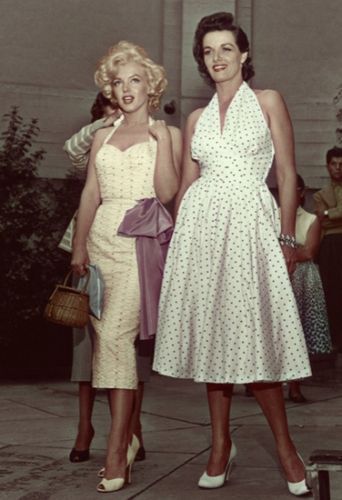

The time has now come for the 1950s, a decade that I’m sure we are all more familiar with. Poodle skirts, Grease, Marilyn Monroe, all of that good stuff. I know when I think of this decade grease (the movie not oil) is especially what comes to mind, but that might just be me. I remember watching that movie for the first time in my childhood best friend’s basement and being so confused (I was 8 or 9 so cut me some slack here) but still interested. Olivia Newton-John’s character Sandy had this black outfit that I will always associate with the 50s. I don't think I knew much else at the time, besides the classic blond bombshell trope that the time period is known for so for me this was a whole new world. Quite obviously, since then I’ve definitely learned a lot more about fashion and it’s evolution through the decades (I wouldn’t be doing this blog otherwise). Let’s get into it then …

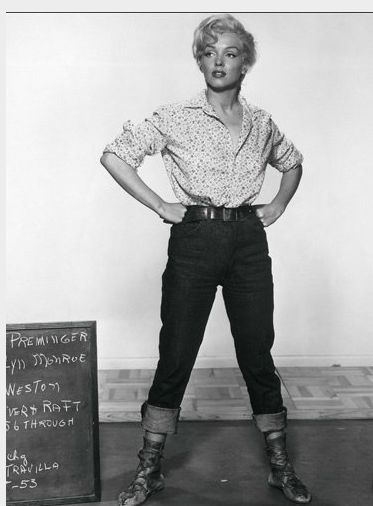
Now, I can't talk about the 1950s without dedicating a good chunk of this post to icons that changed the fashion game. So, first is our blonde bombshell of the 50s. I couldn't do this without bringing up Marilyn Monroe could I? One thing she really popularized was blue jeans (so did other people, like Elvis) which she wore in one of her movies. Now, we obviously all wear jeans all the time, especially Levi 501s. Fun Fact, these are my go-to jeans, just like many people for the past 150 years. Not only did she popularize them but she also showed a different side to jeans, one that balanced glamour and femininity with comfort and practicality. Marilyn is the idea of femininity for a lot of people and I think that this definitely shines in her jean outfits. I think this is something she does really well. Jeans are versatile and can go either way depending on how you style them (which is quite different from fashion before). I do have to say I do love Marilyn Monroe so I might be biased here. I’ve had a massive poster in my room for years (right next to a Kate Bush poster and a Bangles poster). Now, Marilyn is known as being a sex icon and her glamour. The blonde hair, the red lips, the dark eye makeup and the accentuated figure. This is a key part of 1950s fashion, but it's not the only side.


Now, Marilyn is known as being a sex icon and her glamour. The blonde hair, the red lips, the dark eye makeup and the accentuated figure. This is a key part of 1950s fashion, but it's not the only side. Audrey Hepburn is the perfect example (not saying that either is better, but the different aspects of the decade, love them both equally). Her style is a more subtle femininity, one with more elegance. Accordingly, she popularized ballet flats, big sunglasses and capri pants. Personally, I'm really not a big capri pants fan, especially myself, but I think she manages to make them look good. I always feel like they just look awkward and weird. Like why? What’s the point of the length? They’re not short enough to be shorts, but not long enough to be pants. I want to know who got up one morning and said “You know what we need? Pants in that awkward in-between length? That’s what’s missing from my life” Why? It also always makes me think of being a kid and wearing those plaid capris that were popular in the 2000s-2010s and are horribly ugly (if you know what I'm talking about then you’ll get what I mean, if you don't, consider yourself lucky). On the left picture below is Audrey wearing capris for her movie Sabrina (great movie by the way, 10/10 would recommend if you haven’t watched). For some reason I think they look good in this outfit, it's simple but cute nonetheless, and the capris somehow aren't evoking a visceral reaction so I consider that more impressive than anything.
She is also wearing ballet flats in this image, which I will always consider to be timeless and cute. A classic black flat is something that you can never go wrong with. They add just the right amount of elegance to any outfit (like the capris in this outfit) which again is something the 50s really gets right, the art of elegance and femininity.
On the right is an image from Breakfast at Tiffany’s (one of my all-time favourite movies, I’ve watched it a dozen times since I was 10). As you can see she is rocking the chunky sunglasses, which I can absolutely get behind, unlike the capris. I love chunky sunglasses, and they are absolutely a must-have for me in the warmer months. I think some people look better with smaller sunglasses and can absolutely rock them, but I am not one of those people. I wear big sunglasses for the same reason I wear big earrings, it's necessary when you have curly hair (and a lot of it). Smaller pieces just get lost and it becomes pointless. I guess I just have to thank Audrey Hepburn for being able to wear big sunglasses.


That brings us to the end of this segment. From Marilyn Monroe’s sensuality to Audrey Hepburn’s elegance, the 50s fashion trends continue to remain timeless.
Next up, I’ll be talking about my favourite decade so stay tuned !! See you next week xx.
4 notes
·
View notes
Text
It's now time to talk about the tumultuous 40s


Now fashion may not be the first thing that comes to mind when we think of the 1940s. Considering this was the decade where the second world war took place, and a horrific genocide that slaughtered millions, fashion isnt at the forefront of our minds. Oddly enough though, it is during this time that many fashion designers that we know today (namely Hugo Boss, Coco Chanel) were known Nazis, and produced the SS uniforms. Obviously I think that's horrific and want to keep that in mind as we go through this decade.

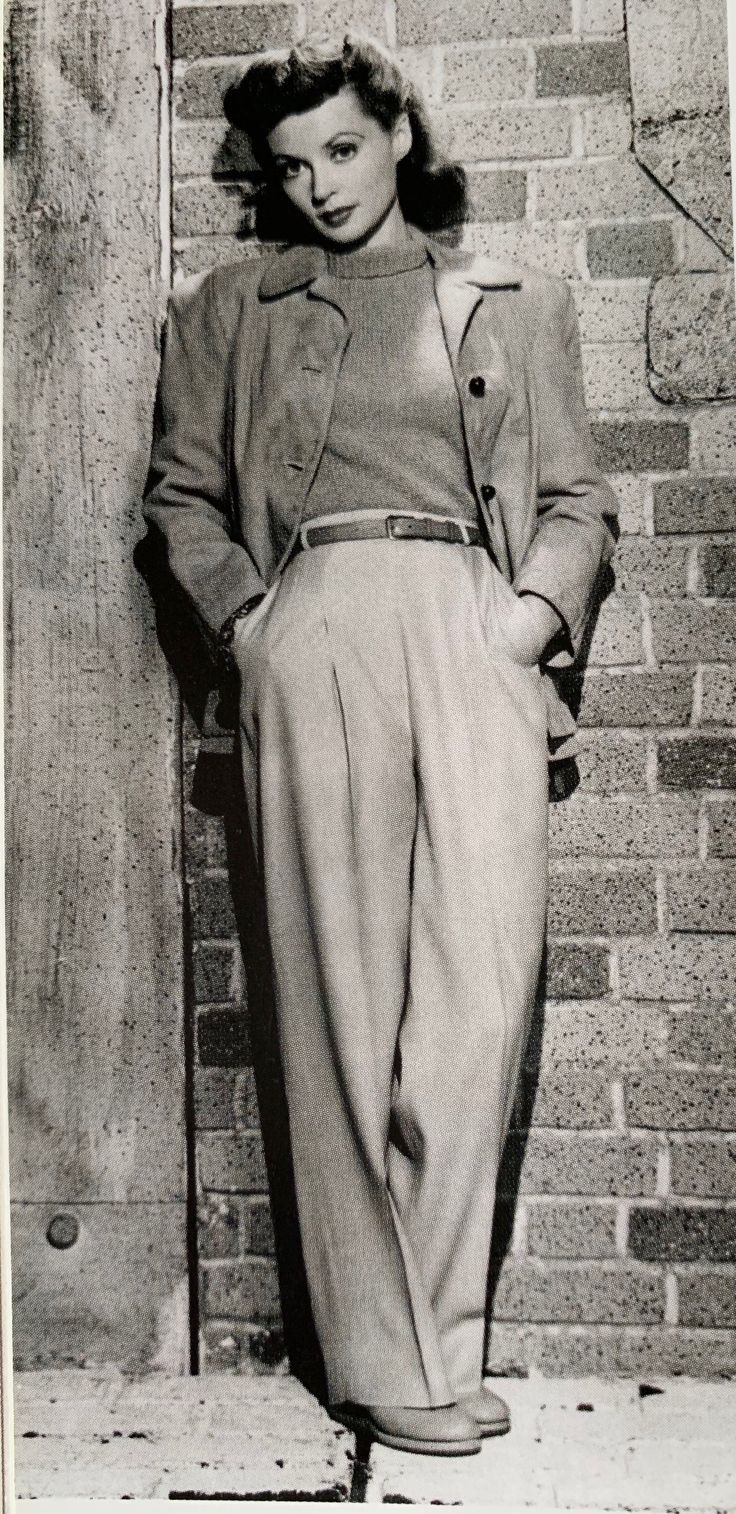
With that said, the 40s are known for its simplicity. As we know, I really do prefer this. I think simplicity is under appreciated and we tend to get lost in the vast variety of clothing available to us. It’s always good to get back to the basics when in doubt. Because of the war, the priority of fashion was practicality and the materials available were limited. This created a simple, practical style, and I honestly really like the idea of this. As much as I love fashion, for an everyday sort of thing, you have to be practical. It’s for this reason that I opt for my 1460s docs as my shoes most days for example.
Above, you can see two outfits that to me really encompass the 1940s. Women started really wearing pants all the time during this decade (popularized by Katherine Hepburn, among others), because of the practicality, which of course I like. I think nicely fitted dress pants or plain cotton pants (like the ones seen above) can really go a long way. The simple cotton fabrics look elegant. It’s simple, casual, but chic and tasteful. To me, it is the perfect effortless look, the first image especially. It's why I love linen pants and tops, especially in the warmer seasons. Those white, plain cotton button down blouses (seen on the left) are a key component of this decade (which I love!!!). Belts (second image) and other accessories are also seen, which as we’ve established I am a big fan of. These looks are really what dominated the 40s. Underrated in my opinion, not everything has to be crazy and flashy to be fashionable.

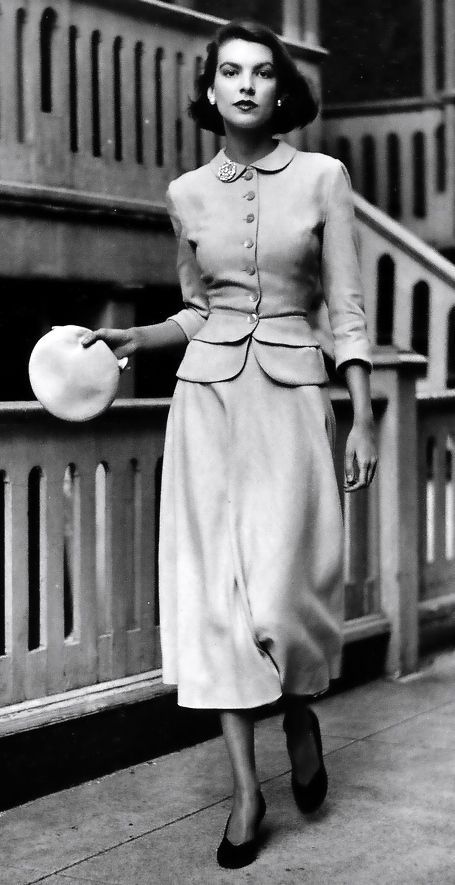
The next look I want to talk about is the more “feminine” and dressier side of the decade. This would be the less practical side (which I still love), the more fashionable side if you will. As you can see, long hemlines were popular during this era. On the left is a dress, with the fitted waist that was common. I personally love this dress. It's modest, as to be expected for war times, but also feminine. It’s of course simple, but the little details are really what I love. The buttons match perfectly, the belt is exactly what’s needed (in my opinion) to add shape without losing elegance. I love the belted-waist, and it is something I even do with my own dresses and such (that are looser or cut similarly to the one in the photo). The gloves are also a nice addition, which was also popular during this time. As I've previously mentioned, I really do prefer simpler, more sophisticated, elegant, and classically feminine looks. This is really what the first look means to me.
Similarly, the second image is simple but fitted enough. It’s a two piece, a long hem lined skirt with a matching blouse/top, which recurs throughout the decade. Once again, the little detail of the buttons add a nice touch. Maybe that’s a strange thing to notice, but I really do love buttons, especially on sets like this. They add a nice little flair, and have to coordinate with the rest of the outfit. That may just be because I'm the type of person that focuses on small things. But it's because of people like this that we have to make sure everything is coordinated. The collar in both outfits is also high and very specific to the decade of the 1940s (and a bit before, as well as after), which matches the modest elegance I talked about.
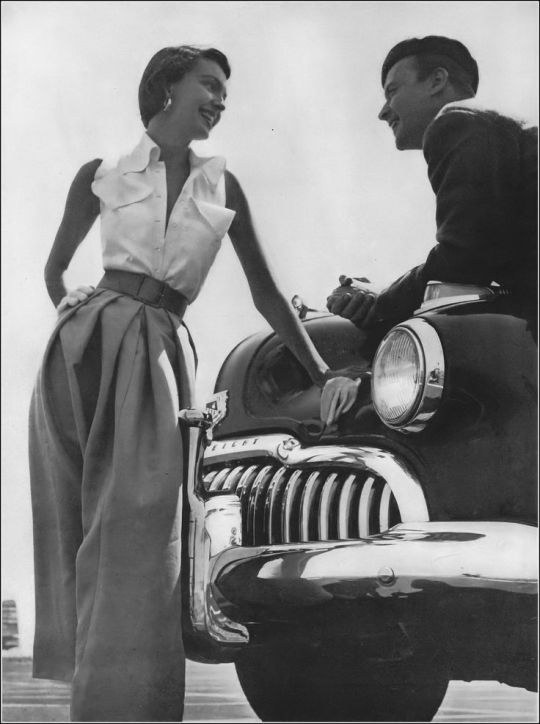

That brings us to the end of this era. Thanks for reading and following around yall, and stay tuned for the next decade as we are approaching my favourites xx.
17 notes
·
View notes
Text
Moving onto the 1930s…
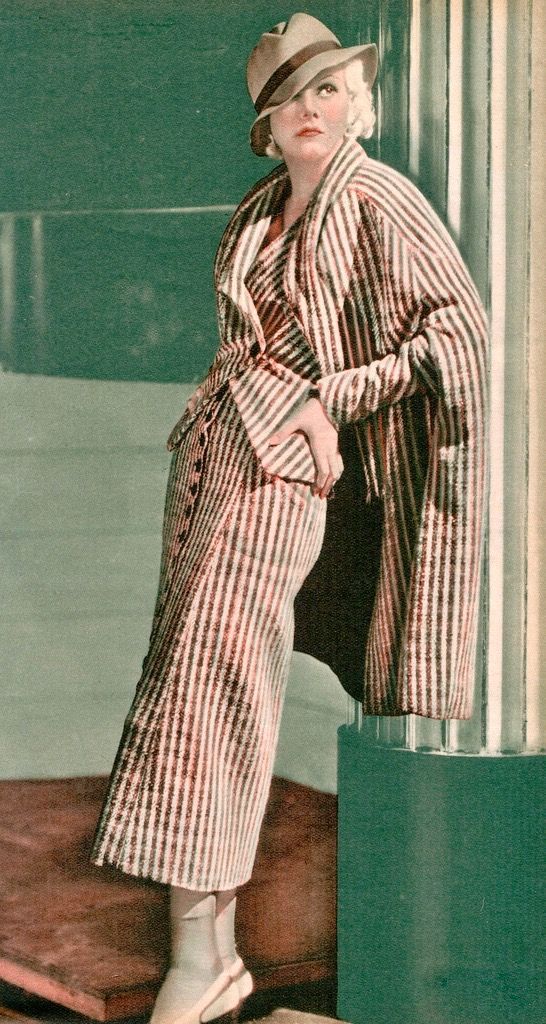

This decade is quite different from the one of the jazz age. Where 20s fashion is free and rebellious, 30s fashion is sophisticated and traditional. Don’t be fooled though, just because this decade is more conservative than the last one doesn't mean it's any less chic. Honestly I much prefer the look of the 1930s, it's more practical and more tasteful. While the flapper fashion is fun and almost frivolous, it’s not exactly ideal outside of special occasions. Maybe that’s just the type of person I am. This decade tends to be forgotten (probably because the 1920s was so iconic) but doesn’t mean it should be.


Let’s take a look at some of the key components of 1930s fashion. Unsurprisingly, this is another decade that was heavily influenced by hollywood. The difference is that the 30s are more glamor heavy. The first big Hollywood star that changed the game is Jean Harlow. Some hate her, some love her. Personally she’ll always remain an icon in my mind. I always think of watching her old movies with my grandma. I remember watching hell’s angels with her for the first time and realizing she was the blonde bombshell of her time. I don't think I'd really known her before having watched this movie, but once I did I remembered her. Now when I think of this era, she’s the first thing that comes to mind with her striking platinum blonde hair and glamor.
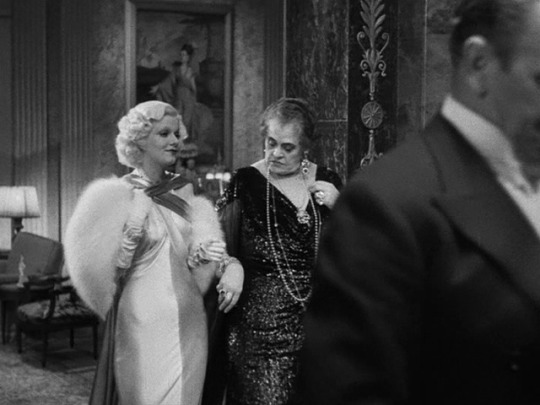
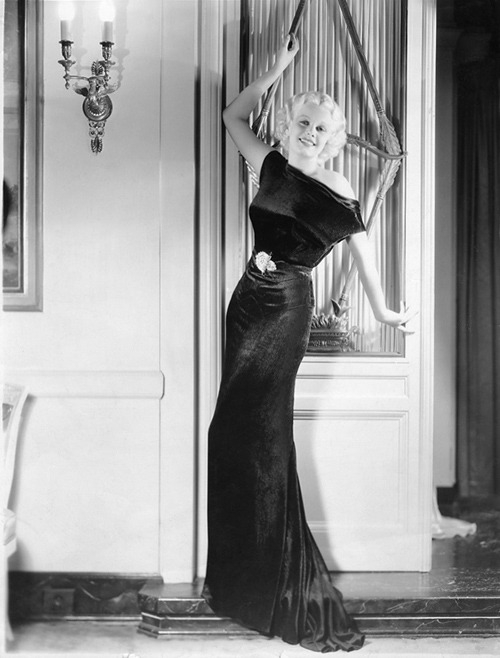
Starting with the outfit on the left here, we can see the famous look in the 1933 film "Dinner at Eight". Starting with the outfit on the left here, we can see the famous look in the 1933 film "Dinner at Eight". In classic Jean Harlow fashion, I think the dress is the perfect mix of sophistication and glitz. I have to say, I'm not normally a fan of the criss-cross necklines in dresses, and I'm not really a fan here either. I will say I dislike it less than I normally do here though, I think the rest of the dress really balances it out. This decade is really where we see longer hemlines, more fitted dresses, and higher waistlines (as you can see). I really like this though, I think these additions give a lot of room for potential. This dress is simple enough actually, but with the addition of the fur shawl/coat it’s the perfect evening gown. I’ve said it before and I'll say it again, I really do love fur coats. In this case, I think it really elevates the plain dress, which is exactly what the 1930s is about. Sophistication and elegance.
Next, on the left is a simpler evening gown. I much prefer this one to the first one. If I was living in this era, I would definitely go for the second look. It’s simple, black, but elegant. I prefer black dresses for evening gowns for sure, I really think there's no need for any crazy colours. Simplicity is elegance. I personally always tend to go for black dresses and darker colours. The neckline is simple but not plain. The hemline is long, as an evening gown should be (or at least I think so). It's sophisticated with the right amount of glamour.
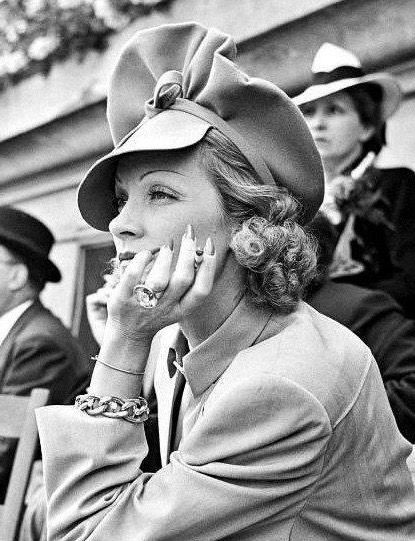
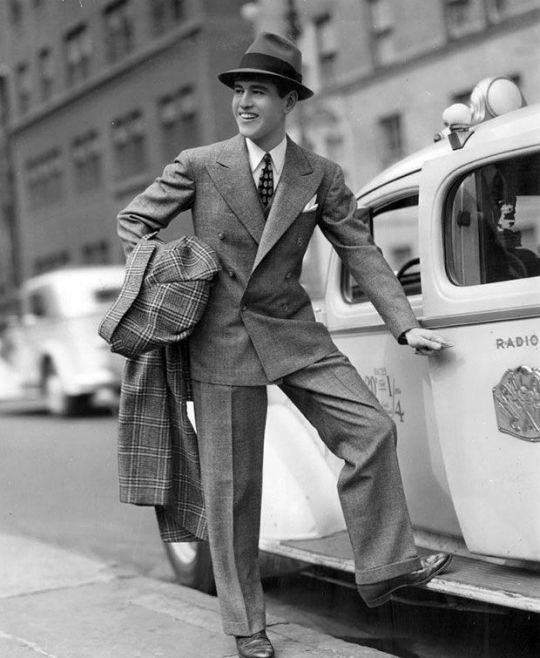
This is also the decade where fedoras and hats became especially popular. Once again, I actually really like hats. I think they're fun and add another dimension to an outfit. Fedoras are especially interesting. They’re not too crazy (not like the hat depicted in the left) but not too simple. Fedoras specifically are very versatile. On men, they can add sophistication to an outfit. On women, they can do the same, or they can be a statement piece, depending on the rest of the look, which I really appreciate. I really like versatility in fashion, it's always best to have some staple versatile pieces than a bunch of different pieces. Quality over quantity is my motto really and the 1930s really gets that.
See you next week, xx.
4 notes
·
View notes
Text
For our first installment, I’ll be covering the first decade of this blog, the 1920s. When I I think of this era, I envision the roaring twenties, full of flapper dresses and glamorous time in fashion. A period full of parties in a world seen through rose-tinted glasses. I think of overindulgence and socialites. Of course, art is a representation of culture, they go hand in hand. Fashion reflects the times, and if there is one thing about this era in fashion, it reflects its optimistic and almost carefree culture. Now, enough of my rambling, onto my favourite parts of 1920s fashion.


This is when Coco Chanel made the flapper dresses we all associate with the twenties especially popular. This dress style can be seen above worn by Joan Crawford, a Broadway icon of the times. During this decade, the go-to party dress was straight with a dropped waistline, low cut back, square neckline, and was often decorated with strings of shiny beads and jewelry.
Oddly enough, the hemlines were not as short as you'd expect in a dress like this. Honestly I think the longer hemline fits better with the dress because it already has such a low cut back. It would be too much otherwise. I think the hemline fits with the dress, the best advice in fashion is you don't want 20 dresses in 1 dress. I remember my mother's tailor saying this just about every single time she was getting a dress made. That is something that will always stay with me. An outfit has to be harmonious, and harmonious the flapper dress is. The beads and decorations are flashy, but not too much. I really cannot stand overly flashy clothing, it just ends up looking tacky. It's fun and it's free but not too crazy, just like the lifestyle. Although they’re not very fitted (straight cut), I still think they’re very stylish and elegant. If I lived during this time period, I would absolutely be wearing flapper dresses on a night out. I'd honestly pick them over a lot of the styles we have today. Simplicity is key.
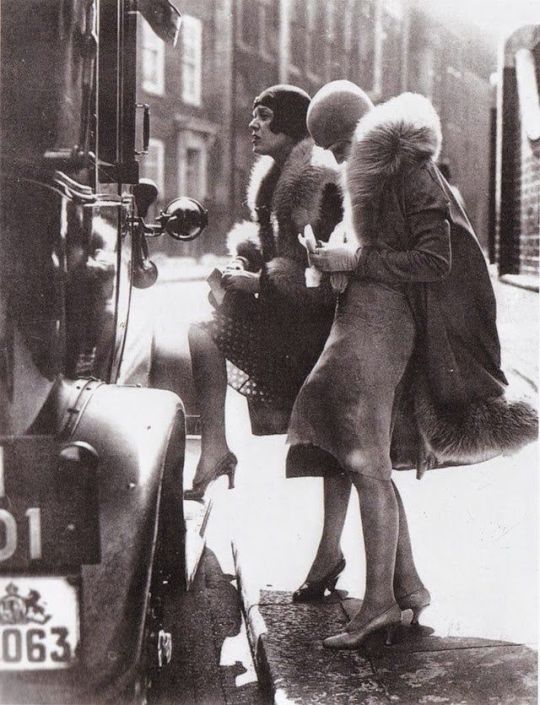
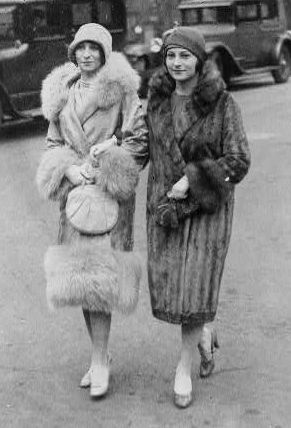
Of course, no party dress is complete without a decadent shawl or coat, which they definitely loved to wear during this time. I completely adore this idea. I think it adds an additional dimension to the look and really just makes it that much more glamorous. These coats never fail to remind me of a book that I absolutely love, entitled Tender is The Night by Scott Fitzgerald because of how rich they are. I remember reading it for the first time in grade 9 and thinking what a time the roaring twenties must have been. Oddly enough, I also get reminded of the third season of The Vampire Diaries where the characters revisit their time in the 20s.

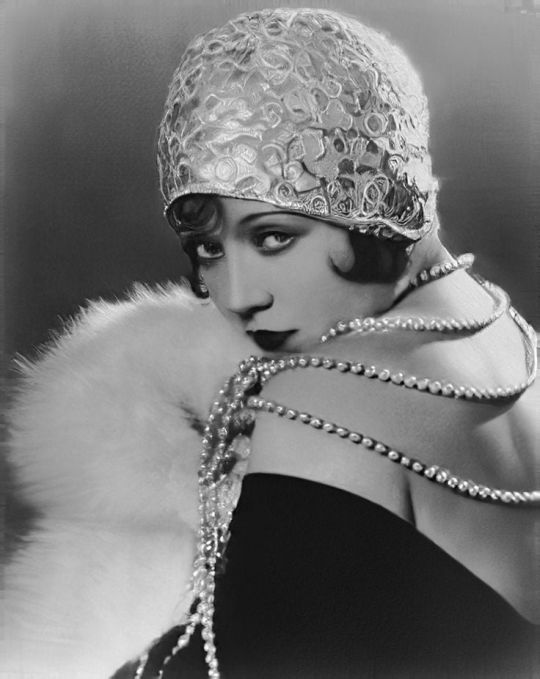
Now, the important thing to note about the 1920s is this is when fashion started becoming more accessible. Clothing was no longer a status symbol. I for one love this idea, and I think it's nice to see a time where everyone was presentable all the time because that was the standard. Personally I love the feeling of being put together. Otherwise, I feel like a mess, and I think overall everyone just looks better when they're in a proper outfit. At this time, women wore dresses at the time, with lots of accessories, whether it be hats, purses, jewelry, or whatever else. It's strange now to see people wearing hats all the time, and quite eccentric ones at that, but I truly adore the idea. It makes me think of the one scene in Breakfast at Tiffanys (yes, I know it takes place during the 1960s) where Audrey Hepburn is walking down the street in a red coat with a matching hat. That outfit will forever be iconic to me because accessories take an outfit to another level. A simple straight-cut dress becomes a fun look with the right heels, hat, and jewelry. That is the key to the 1920s look. That’s what I believe to be the best fashion tip out there. And of course, don't be afraid to make it a little fun. We'd all do well to remember that sometimes.
Until next time, xx.
20 notes
·
View notes
Text
Hey everyone! Welcome to my blog. I'll be going through the most exciting part of culture, fashion of course. From the rose tinted 1920s to the iconic runways of the 2000s, we’ll be covering it all; fashion trends, memorable looks, my personal critiques, style icons, and the biggest influences on fashion. Follow along as I cover everything from Jane Birkin to Kate Moss. Can't wait to see you on my first segment xx.



6 notes
·
View notes